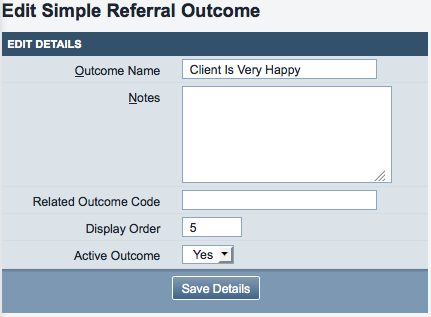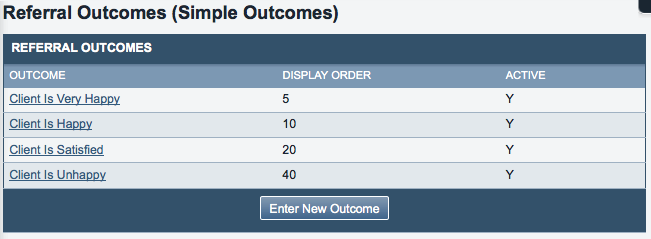Outcomes (Administrator guide)
Measuring outcomes is one of the most popular reasons for implementing Charitylog. Charitylog's Reports Section allows detailed reports on all activity logged, and this goes most of the way to telling you what you need to know about your organisation's activity. These are usually called "hard" outcomes, which can be measured in numbers. However, there will probably still be other things you need to measure - for example, whether clients are happy with the services you provide, which is usually called a "soft" outcome. You might also want to measure even more intangible things; for example, whether a client's self-confidence has improved because of the services your organisation provides.
Outcomes make this possible. Charitylog has two kinds of outcome measurement available - Simple Diary Outcomes and Ladder Outcomes.
Contents
Referral Outcomes (Simple)
Simple Diary Outcomes are on their way to becoming a legacy feature, and may be deprecated in a future version. We advise that new systems are set up to use Ladder Outcomes instead. In some cases, classification codes may also suit.
Simple Diary Outcomes are intended to capture one-off measures, at the end of each referral. They are available to all projects, which means that they are best suited to broad, non-specific measures which can apply to every project. For example, consider this sliding scale which measures how happy the client is with the service they have received today...
A simple measure like this is ideal for mirroring using Simple Diary Outcomes.
Simple Diary Outcomes are accessed from the "Referral Outcomes (Simple)" menu item, which is found in the "Outcomes" submenu.
Clicking this menu item will take you to a display of the simple outcomes set up on your system, if there are any. To add an outcome, click the "Enter New Outcome" button.
You can now enter the first outcome, adding a display order, notes and an associated reporting code if you need one.
When all the outcomes from the chart above are set up, the outcome display might look like this.
These outcomes are now ready to use.
When to use Simple Diary Outcomes
Though basic, Simple Diary Outcomes can be a very effective measure of your activity. The key thing when using Simple Diary Outcomes is that staff need to know when to use them. If there is any ambiguity about whether outcomes should be entered or not, users will often tend towards not using them, simply because it's easier! Therefore, make sure that staff are in no doubt as to when they need to fill in an outcome.
Sometimes, Simple Diary Outcomes can work well on a temporary basis. For example, a particular project can fill in a Simple Diary Outcome on every referral for one month. This will give you a snapshot of the project's effectiveness without the relevant staff needing to fill in an outcome on every referral for the entire year.
Remember that Simple Diary Outcomes are system-wide, and are intended to take one measure across your whole organisation. For more complex and Project-specific outcomes, Ladder Outcomes should be used.


